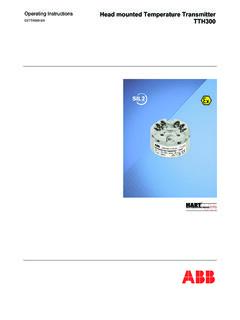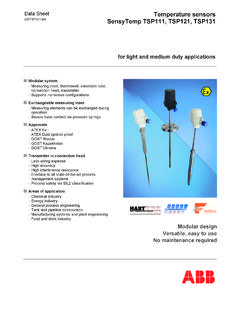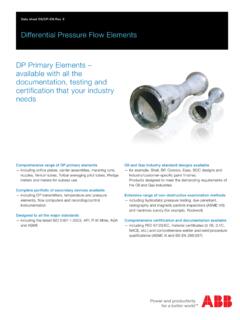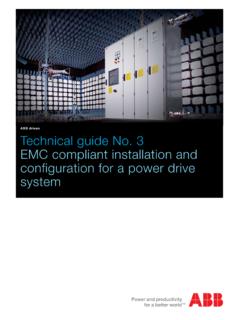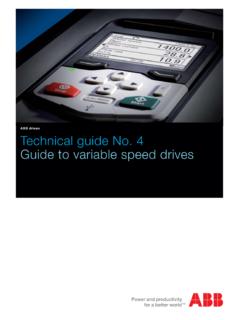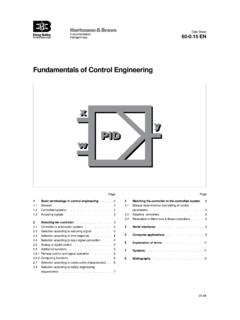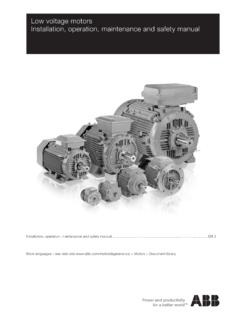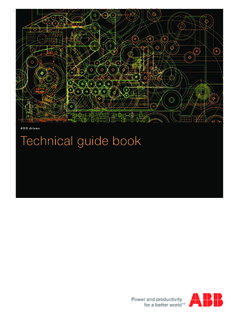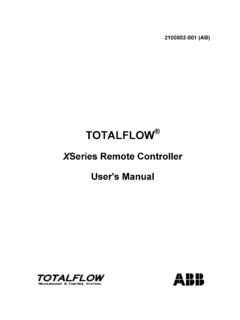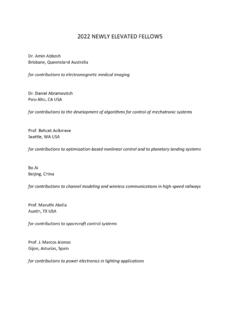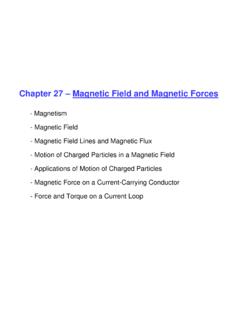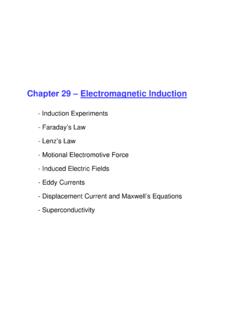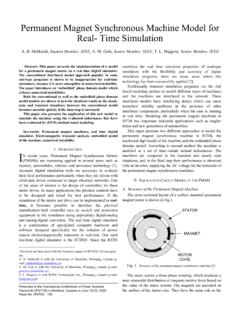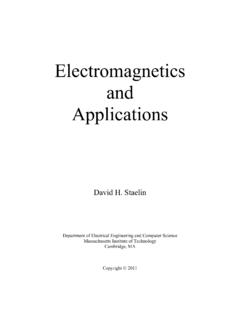Transcription of Automatic Voltage Regulator User’s Manual
1 We reserve all rights in this document and in the information contained therein. Reproduction, use or disclosure to third parties without express authority is strictly forbidden. Copyright 2009 ABB Prep. PEYA AVR EA63-5 USER Manual No. of sh. Appr. ANQU 8 Resp. dept. R&D Document identification Lang. Rev. ind. Sheet ABB Generators Ltd. 8 AMG 5855292 en C 1 Automatic Voltage Regulator User s Manual Type designation: EA63-5 Application: AMG Synchronous Generator Industrial Application Series Document identification Lang.
2 Rev. ind. Sheet ABB Generators Ltd. 8 AMG 5855292 en C 2 1. GENERAL INFORMATION DESCRIPTION EA63-5 is an Automatic Voltage Regulator (AVR) for AMG synchronous generator industrial application series. The AVR is typically supplied by a single-phase auxiliary winding wound into the stator slots. It also can be supplied by permanent magnet generator PMG or phase Voltage of main terminal. SPECIFICATION Table 1: Specifications. Sensing input Voltage : 220/440 VAC (SW1 selectable). 185-290 VAC at 220 VAC. 330-515 VAC at 440 VAC. Frequency: 50/60 Hz (SW3 selectable).
3 49-60 Hz at 60 Hz, preset 57Hz. 40-50 Hz at 50 Hz, preset 47Hz. Power input Voltage : 30-260 VAC. Frequency: 40-500 Hz. Output Voltage : 85 VDC at 110 VAC input. 170 VDC at 220 VAC input. Current: continuous 5 ADC. maximum 40 ADC. Voltage built-up Residual Voltage >5 VAC at 25 Hz. Voltage adjustment < % (engine speed variation within 4 %). Excitation resistance >9 . Current compensation 1 or 5 A> VA (SW2 selectable). Voltage built-up Residual Voltage >5 VAC at 25 Hz. Max 7% at Analogue Voltage input Un 0-15% at 0-10 VDC. External Voltage adjustment VR 10 % with 1 k resistance ( W).
4 C+, C- External filter capacitor terminal. Respond time <1 cycle. Temperature drift < % at -35 to +65 . Dissipation 12 W. Dimensions 140 mm x 125 mm x 43 mm. Document identification Lang. Rev. ind. Sheet ABB Generators Ltd. 8 AMG 5855292 en C 3 DIMENSIONS Figure 1: AVR outline drawing. For enclosure dimensions and mounting holes refer to Figure 1. The protection fuse capacity is 5 A/250 V (slow blow type). Attention! All Voltage readings are to be taken with an average-reading voltmeter Meggers and high-potential test equipment must not be used.
5 Use of such equipment could damage the AVR. Safely secure all wiring connection. Do not install AVR at place with high vibration to prevent loosen connection. For safety reasons please do not touch the heat sink while operating. Document identification Lang. Rev. ind. Sheet ABB Generators Ltd. 8 AMG 5855292 en C 4 2. ADJUSTMENTS DIP SWITCH ADJUSTMENT SW 1 (see: Figure 2) Voltage selection. SW 1 is used to select the suitable genset s sensing input Voltage (S1, S2). When sensing input is 440 VAC (380-480 V), switch the SW 1 to ON.
6 If the sensing input is 220 VAC, switch SW 1 to OFF position. ATTENTION! If system Voltage is 220 V but the SW 1 is set to ON position (440V), it will cause over Voltage . Figure 2: Dip switch (SW). SW 2 (see: Figure 2) is used to select the suitable current transformer s current input (C1, C2). If current transformer s current is 5 A, switch SW 2 to ON position. If the current is 1 A, switch SW 2 to OFF position. SW 3 (see: Figure 2) is used for frequency selection. If genset s rated frequency is 60 Hz, switch SW 3 to ON position.
7 If rated frequency is 50 Hz switch SW 3 to OFF position. ATTENTION! If 60 Hz frequency is selected, while the rated frequency of the generator is 50 Hz, it may result the under Voltage fault. ATTENTION! If a 60 Hz generator is used, but selected frequency is 50 Hz, stop the engine. The over excitation current may damage AVR and generator. If genset power is less than 90 kW switch SW 4, SW 5 and SW 6 to OFF position (see: Figure 2). If the power is 90-200 kW, switch SW 4 to ON position. SW 5 and SW 6 remain in OFF position.
8 If the power is more than 200 kW, switch SW 4, SW 5 and SW 6 to ON position. ATTENTION! Each time when SW 4, SW 5 or SW 6 positions are changed, the stability (STAB) must be re-adjusted to achieve the optimum genset performance. The setting of the dip switches (SW) must be conducted while the generator is not in operation. TRIMMER ADJUSTMENT VOLT Voltage setting (see: Figure 3) is used to adjust the genset s rated output Voltage . When SW 1 is ON (440 V), the adjustable range is 330-515 VAC. When SW 1 is OFF (220 V), the adjustable range is 180-270 VAC.
9 ATTENTION! AVR AC Voltage readings are all average values. Ext. potentiometer Connect W potentiometer with 500 resistance to the VR terminal (see: Figure 3). The adjustable Voltage range is 5 % of Un. With 1 K resistor the adjustable Voltage range is 10 % of Un. If this function is not required, please short circuit these two terminals. STAB Stability adjustment (see: Figure 3). It must be conducted while the generator is operating without load. At first, adjust the STAB potentiometer (POT) clockwise until the Voltage becomes unstable.
10 Then, adjust to anti-clockwise (approximately 1/5 of rotation) as the Voltage just reaches the critical point (knee point) of stabilization. The Voltage is now stable, but very close to become unstable. 123456O NS W Document identification Lang. Rev. ind. Sheet ABB Generators Ltd. 8 AMG 5855292 en C 5 U/F Under frequency protection adjustment (see: Figure 3). When generator s driving speed falls below the knee point, the under frequency protection circuit will begin to intervene. The Voltage and frequency begin to decrease in linear descend.
